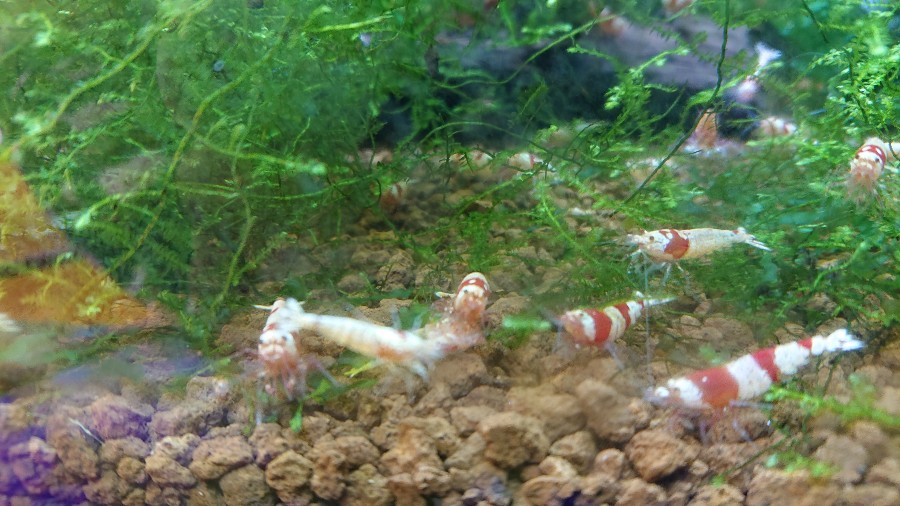Ever looked inside an aquarium and wondered how the glass stays so clean? You may have noticed one or two crustaceans swimming around the aquarium as well. Do you know what those little shrimp are commonly added to aquariums for?
Shrimp typically do clean their aquarium glass. They eat the algae and other organic waste that would otherwise make the aquarium look cloudy. This behavior is not unusual as the algae provide nutrition to them. Some cleaner shrimp also clean their client fish in a symbiotic relationship.
Read on to learn more about shrimp and how well they can clean aquarium glass. I’ll also cover the importance of getting the right species and another service these little crustaceans can sometimes provide, so read on!

Why Shrimp Clean Their Aquarium Glass
Shrimp clean their aquarium glass because the algae is a major source of their nutrition. They typically spent their entire days searching their environment for algae, bacteria, and other organic products to eat off the hard surfaces.
Note that the shrimp we typically keep in an aquarium not only cleans the glass but also goes through every other hard surface in the water. These surfaces include the aquarium’s floor, the surfaces of fake (or real) plants in the tank, rocks, and even other fish.
What Shrimp Eat When Cleaning the Aquarium
As I’ve explained above, shrimp clean the aquarium because they consider all that organic material food. In other words, they derive nutrition from the organic materials they eat when cleaning. But what is it that they eat?
Here are a few things you can expect shrimp to eat in your aquarium, whether big or small.
- Algae: These are the slimy aquatic plants that form in aquariums over time. They cause the tank to appear cloudy, but the cleaner shrimp eat them as a source of vitamins and minerals.
- Bacteria: Although it might sound disgusting to us, cleaner shrimp love feeding on small bacteria floating around in the aquarium water.
- Parasites (worms): Whether they are parasites floating in the tank, or worms that have invaded other fish in the aquarium, parasites are a major part of a cleaner shrimp’s diet. The shrimp eat them dead or alive as a source of protein and other nutrients.
- Dead fish: Whether they die of natural causes or not, cleaner shrimp love to nibble on fish after their death. However, I wouldn’t suggest keeping a dead fish in your aquarium for too long because it could start to rot and release a lot of unwanted smells from the tank.
- Organic waste: Fish typically eliminate their organic waste in the water, and cleaner shrimp usually eat that too. Whatever your other aquarium fish couldn’t digest, the cleaner shrimp can definitely make use of! They also eat dead tissue from other fish.
As you can see, cleaner shrimp eat a lot of the unwanted materials that are typically floating around in an aquarium.
These materials will accumulate if you leave the aquarium without any shrimp inside. Pretty soon, the glass turns grimy, and the water gets cloudy. It’s a lot more difficult to clean the water once it has turned color, and it can be a toxic environment for your other fish.
Typically, you would need to clean out your aquarium every week. However, adding the shrimp will allow you to extend this time to about two weeks, reducing the work you must do.
Cleaning Other Fish
Whether in the wild or inside the confined space of an aquarium tank, cleaner shrimp are known to set up cleaning service stations. They are also known as marine life cleaning stations, where the shrimp provide a service to their “clients” by cleaning parasites and other dirt from on them.
The clients in this scenario are other fish that need to rid themselves of the parasites that are depleting them of their energy stores and making them sick. The relationship between the cleaner shrimp and their client fish is symbiotic.
In other words, both species benefit from these cleaning stations. The client fish get cleaned and are freed from their parasites. On the other hand, the shrimp are provided a nice meal without having to work for it—no long hours spent searching for the food on lots of hard surfaces.
Some species of cleaner shrimp that are sold for small aquariums provide this service, and I would suggest adding them to the tank if you want to care for the rest of the guppies in your aquarium.
Cleaner Shrimp vs. Other Species of Shrimp
While all shrimp can be classified as bottom feeders, not all species are added to aquariums as “cleaner shrimp.”
The fundamental quality differentiating cleaner shrimp from other species is that they are aggressive feeders. In other words, they spend a major proportion of their time eating, which means they are cleaning.
If you add other shrimp species to your aquarium, they may not fare well amongst other marine species you have included. Also, they will not clean the aquarium as vigorously. In other words, you won’t be able to enjoy the aquarium as much.
Note that some species of shrimp exhibit aggressive behavior. This behavior would pose a serious problem in confined spaces such as small aquariums where they need to socialize better with other marine species.
I would not recommend adding shrimp to your aquarium except for fire shrimp and cleaner shrimp. The shrimp should be added to protect the other fish and keep the glass clean, and for that, you need fire shrimp and cleaner shrimp, not any other species.
Final Thoughts
Cleaner shrimp are an excellent addition to any aquarium, as they will spend hours cleaning up the glass and other surfaces. If you really want to enjoy looking into your aquarium through crystal clear glass, this is an effortless way to achieve just that.
Make sure to get the right species of cleaner shrimp, so they can thrive in your aquarium without having any issues with the other residents. Ask the aquarist at your pet shop for advice on caring for the specific breed you purchase, particularly regarding water salinity and temperature.
Sources
- Aquarium of The Pacific: Pacific Cleaner Shrimp
- Coralia: Marine Life Cleaning Stations
- Natural History Museum: Mutualism: Eight Examples Of Species That Work Together To Get Ahead
- Fishing Kris: Bottom Feeders – What Fish Are Bottom Feeders (And which to Avoid)
Recent Posts
Guppies are popular in community aquariums. However, a common misconception is that they can’t live with shrimp. Is this true? Crystal Red Shrimp can live with guppies. Both guppies and Crystal...
Cherry red shrimp, aka red morph or cherry shrimp, is a species of the Atyidae family. The Neocaridina davidi species has many variants, but the red cherry shrimp is more popular and widespread. This...

